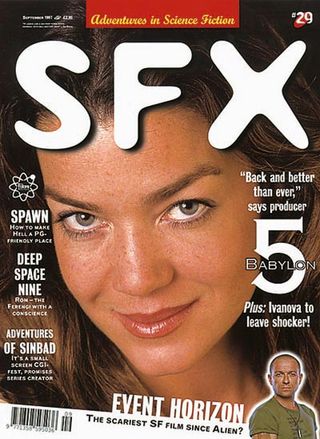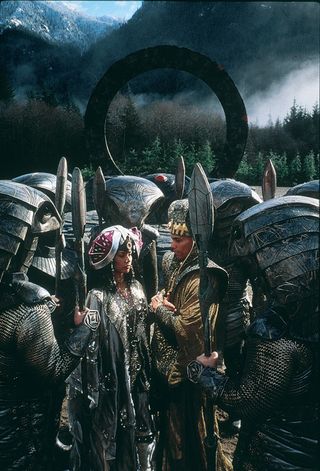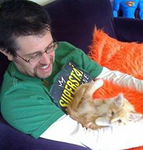SFX Issue 29
None

September 1997
SFX historical notes: Remember, when reading the beginning of this article – Buffy, at this point, was still (just) in the future…
Gatecrashers
Will Stargate , the big screen SF hit of 1994, make it to the TV intact? “It’s not a limited series,” executive producers Jonathan Glassner and Brad Wright tell SFX

Hit movies either spawn sequels or TV series – and, on balance, the former is the lesser of two evils. Logan’s Run the TV version was a typically banal slice of ’70s sci-fi, while Beyond Westworld was so bad it’s a surprise the film’s director Michael Crichton didn’t sue for defamation of character. But there are exceptions, notably Alien Nation , which matured into an excellent series that explored themes the movie only touched upon. And it’s into this rare category that the producers of Stargate SG-1 hope their creation will fall.
Not that the omens are all good. Stargate director Roland Emmerich is allegedly none too keen on the series going ahead, although executive producers Jonathan Glassner and Brad Wright can at least take heart that production company Trilogy is so confident it has got a hit on its hands that it’s already commissioned 44 episodes to follow the pilot, “Children Of The Gods.” This is a huge commitment by normal US TV standards, so how much is it costing?
“A lot!” the two producers laugh in unison when SFX chatted to them mere weeks before the pilot was due to air in the US on Sunday 27 July.
Sign up to the SFX Newsletter
Get sneak previews, exclusive competitions and details of special events each month!
“Put it this way,” Glassner adds with a smile. “I’ve produced a lot of TV in the past ten years, and this budget is way higher than any I’ve ever worked on before.”
“We don’t do anywhere near the amount of effects and CGI that Babylon 5 does,” Wright admits. “But we do have a high ratio of post-production to production time. For the two-hour Stargate pilot, we wrapped production in mid-March, and we’re still doing the visual effects. We’ll finish right under the wire for our delivery date, which is at the end of July. There are over 200 effects shots in it.”
The pilot, penned by Glassner and Wright, picks up with O’Neill (Richard Dean Anderson replacing the movie’s Kurt Russell) having completed his mission, although he stops short of closing the gate on the desert planet of Abydos for fear of killing team member Daniel Jackson (played by Michael Shanks in the role originated by James Spader). But when snake-helmed aliens attack through the Stargate on Earth, O’Neill admits to his superiors that he disobeyed orders and that Jackson may, in fact, still be alive. However, O’Neill does not believe the aliens are from Abydos, so a new team is formed and returns to the planet – where they find Jackson alive and well, and married to a native girl. They also discover a map of Stargates throughout the universe, but are not alone in this discovery. Soon, alien attackers intervene, take hostages and are pursued to the primitive planet Chulak (which probably looks somewhat like British Columbia). The struggle is now on.
Both Glassner and Wright admit to being fans of the original movie.
“We liked it a lot,” Wright says. “We’re fans of science fiction and I’ve been reading science fiction novels my whole life.”
“I’m a little bit less well-read in science fiction,” Glassner admits. “I kind of stumbled into the field. I was doing cop shows and dramas for years, and just about every genre you could name, except for comedy. And then I started writing Alfred Hitchcock Presents , a genre show but not really SF, and did very well at it. From there, Lorimar put me on a show called Freddy’s Nightmares – The Freddy Kreuger Show!”
It’s clearly the duo’s hands-on experience in the US television industry which served them in good stead when it came to getting control of Stargate SG-1 ...
“I’m originally from Roanoke, Virginia,” explains Glassner. “I studied film and television in college and moved to Hollywood, where I slowly worked my way up the ranks of writing for various television series. I also did a two-hour movie called Island City . Then I went on to The Outer Limits , and I did that for three years, before working for Trilogy [Trilogy consisting essentially of Pen Densham, Richard B Lewis and John Watson].”
Toronto-born Brad Wright, however, does have an impressive number of SF TV writing credits, having contibuted to shows like Highlander and Forever Knight , as well as the pilot episode of Showtime’s Poltergeist: The Legacy . Both men are part of the West Coast scene – west coast of Canada, that is.
“We produce the show up here,” Wright explains. “Jonathan and I are executive producers of Stargate SG-1 and we’re both co-executive producers of The Outer Limits , but we answer to Trilogy. How we ended up on Stargate is kind of a fun story. Doing The Outer Limits together, we’d been partners for various projects. We did a couple of shows together that I wrote and he put them together and directed them. It’s kind of funny, because we learned that when MGM was planning to go ahead with a Stargate series, each of us individually contacted our agents to try to pursue it. Then we found out and decided we should do it together. After that, MGM got involved and basically said, ‘Why don’t you guys do it?’”

Perhaps the biggest early coup in the series’ development was the casting of MacGuyver ’s Richard Dean Anderson in the lead role of Air Force Colonel Jack O’Neill.
“We got lucky!” Glassner says, laughing. “When we started casting, we bounced around who we thought would be ideal. The president of MGM Television happened to be friends with Richard Dean Anderson [he was an executive at Paramount when MacGuyver was being produced]. We said, ‘Do you think we can get him?’ He said, ‘Well, let me call.’ Well, he called... And here he is!”
Though the supporting regular cast is relatively unknown, Alan Rachins ( LA Law ), Harley Jane Kozak ( Parenthood , Dark Planet ) and Armin Shimmerman ( DS9 ) have already shot guest appearances.
Stargate SG-1 ’s pilot also provides a new race of villains (by necessity, since Ra was killed in the movie): parasitic snake creatures called Goa’ulds who use human bodies as hosts to survive (and fie on anyone who says, “Hmm, that cuts down on the make-up effects budget.”). But is the series going to be one long battle against these new creatures on the same planet, or do the producers have bigger plans?
“We learn in the pilot that there are many Stargates all around the galaxy,” Wright reveals. “There are 39 symbols on the Earth Stargate. Various combinations of those symbols key in other Gates.”
So the show will visit other planets, then?
“Absolutely,” says Wright. “We want to build a complex mythology about how the Stargate network came to exist, who put it there, what species Ra came from and how their whole culture works. It unfolds as the series goes on.”
“So far,” Glassner quips, “the plotline sits in Brad’s and my head!”
“We have a schematic and it keeps growing week after week,” Wright adds.
“We’d very much like to go a good long time,” Glassner admits. “The 44 could be just the beginning. It’s not a limited series.”

Dave is a TV and film journalist who specializes in the science fiction and fantasy genres. He's written books about film posters and post-apocalypses, alongside writing for SFX Magazine for many years.
Most Popular


